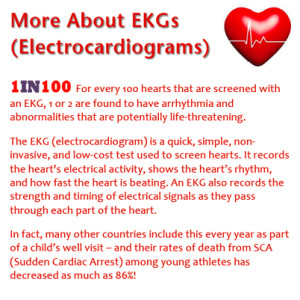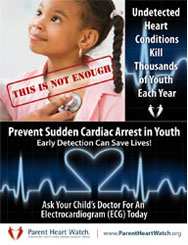Protecting Athletes from Sudden Cardiac Arrest
Imagine a busy night at the gym coaching practice and one of your cheerleaders suddenly collapses and cannot be revived. This is what happened to the coach of 17 year old cheerleader Jessica Clinton in October 2003. Jessica collapsed at the drinking fountain from an undiagnosed medical condition called Mitral Valve Prolapse that could’ve easily been detected through preventative testing. Or imagine an action packed night in the studio with your energetic competitive dancers and one suddenly stops dancing and hits the floor and becomes unresponsive. This happened with 11 year old Breana Vergara who died at dance practice in December of 2014 from undetected Wolf-Parkinson-White syndrome, a curable congenital heart defect detectable by preventative EKG testing.
Sudden Cardiac Arrest (SCA) is the #1 cause of death in student athletes in the United States, which is typically brought on by a pre-existing detectable condition that could’ve been treated.
Over 400,000 lives (2,000+ being children) each year are taken from SCA; more than breast cancer, lung cancer, stroke and AIDS combined. When your heart fails from something that could’ve been treated, you don’t get another chance. SCA is not rare, but surviving it is. Dr. Jonathan Drezner, the president of the American Medical Society for Sports Medicine states, “A sudden heart-related death is so incredibly tragic and stunning that people aren’t comfortable putting it into the everyday conversation. I do wish, to some extent, it was something people talked more about because we are getting to a place where we could prevent many of these deaths.”
What can we do as program owners and coaches to ensure our athletes are safe while participating and to help prevent deaths from SCA? Require all athletes to have a yearly physical that includes an EKG.
Prevention
 EKG’s detect two-thirds of the deadly, concealed heart trouble aggravated by exercise. SCA in a young athlete is most commonly set off by a structural heart defect or a problem with the heart’s electrical circuitry that is not usually found during a routine physical. An increasing number of countries and organizations, including the International Olympic Committee, now mandate medical pre-participation screening that includes a baseline EKG with the intent of detecting cardiovascular conditions that predispose to sudden death.
EKG’s detect two-thirds of the deadly, concealed heart trouble aggravated by exercise. SCA in a young athlete is most commonly set off by a structural heart defect or a problem with the heart’s electrical circuitry that is not usually found during a routine physical. An increasing number of countries and organizations, including the International Olympic Committee, now mandate medical pre-participation screening that includes a baseline EKG with the intent of detecting cardiovascular conditions that predispose to sudden death.
A second option would be rather than mandate it, have the test be made as an option available to parents each year. Educate your parents on SCA and what preventative measures they can take. “Let the parents decide,” said Laura Friend, a founder of Parent Heart Watch, a national organization committed to preventing sudden cardiac arrest in children. “No one told me that I could have paid $50 or $100 for a test that would have detected a fatal heart condition in my daughter. I would have paid for that. Offer it to everyone and give the power to the parents.”
Many hospitals now have programs in place to provide young athletes with sports pre-participation EKG’s free of charge. Please visit the Resources section at the end this article for more information.
Know the Warning Signs
1. Fainting or Seizures
Fainting is the #1 warning sign of SCA and usually occurs immediately after physical activity or as a result of emotional excitement/distress/surprise. Sometimes, it may look like a seizure. Don’t assume it is from exhaustion or dehydration.
2. Unexplained Shortness of Breath
It’s natural for your athlete to lose their breath during exercise. However, if your athlete is experiencing shortness of breath during normal activity or their breath loss is severe during or after practice, they should have it checked by a physician. They are trained athletes and should recover/regain their breath at a normal rate after a full out routine or a hard practice, if they are not- this is a warning sign.
3. Chest Pains
If your athlete experiences chest pains, that’s a warning sign!
4. Extreme Fatigue
Of course they will get tired during and after practice, but if they are more sluggish than everyone else or they feel like they don’t have any energy, check it out.
5. Unusually Rapid Heart Rate
If they complain of their heart racing or it feels like it is going to jump out of their chest, their body is telling them something may be wrong.
6. Dizziness
If they are getting dizzy frequently, check it out.
7. Unexplained Family Death
If a family member (under 50 years old) dies/died suddenly, and the cause of death is unknown, it may have been due to an unidentified heart condition.
Have an Emergency Action Plan for SCA
If an athlete collapses, and has the symptoms of SCA, react immediately. Every second counts.
1. Call 911.
2. Send for an AED.
3. Start chest compressions.
By following these steps, you will give your athlete the best chance for survival.
Education
1. All staff should be educated on SCA, know the warning signs, and the action plan. A free course is available on the NFHS Learn website.
https://nfhslearn.com/courses/61032
2. Make it the standard in your program that all coaches are certified in CPR and AED. Contact your local American Red Cross for a list of course offerings in your area. You can also host a certification course at your facility for your staff for more personalized instruction. An AED, properly administered, can boost the survival rate after sudden cardiac arrest by 60 percent or more. “When someone collapses with sudden cardiac arrest, the survival rate goes down 10 percent every minute if the people around the victim don’t know CPR or have an AED,” said Ron Courson, the senior associate athletic director of sports medicine at the University of Georgia and a researcher with the National Athletic Trainers’ Association. “The vast majority of patients will die. AED’s can cost as little as $1,200. We’ve got to get them everywhere.” Get an AED in your program. There are grants available to assist with the cost. Please visit the links in the resources section for information on how your program may be eligible for assistance with getting an AED. Additionally, you can look into purchasing AEDs on sites like https://aedadvantage.ca/shop/aeds.
3. Keep your emergency contact information and athlete medical history up to date. Files should be updated yearly at minimum, or if a change occurs.
Resources
 FREE SCA Printed Materials and Posters for your program
FREE SCA Printed Materials and Posters for your program
Please submit your complete name, organization name, mailing address, telephone number and number of posters to contact@parentheartwatch.org
Parent Heart Watch
Simon’s Fund
Young Hearts for Life
http://www.nytimes.com/2013/05/12/sports/safety-advocates-focus-on-hidden-threats-to-young-athletes.html?_r=0
http://m.local10.com/news/family-urges-parents-to-get-ekgs-for-active-kids-after-sudden-death-of-daughter/33752378
http://www.thenewsdispatch.com/news/article_5fe606be-0be4-11e5-a0a6-8f7072fbf7ef.html#.VXSmC2PlL7c.facebook
http://www.ncbi.nlm.nih.gov/pubmed/19535269
http://www.ncbi.nlm.nih.gov/pubmed/19575156




